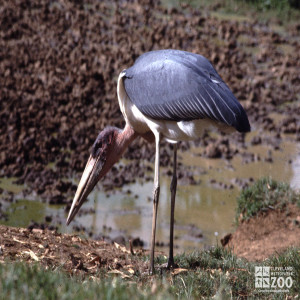Marabou Stork
[Leptoptilos crumeniferus]

The marabou stork (also known as the adjutant stork for its style of marching about) is the largest of the storks. Its short, thick neck is largely naked and is a dull pinkish to brown in color -- the same as the bill. It possesses a naked, skin-covered pouch which hangs down one foot or more from his throat and appears to belong to the respiratory system. The marabou has no crop and an adult needs about 25 to 32 ounces of meat daily. This large bird is 60 in. long, has a wingspan of 9.8 ft. and weighs 11 lbs.Marabous have an enormous sharp bill, capable of dealing lethal blows. The birds are scavengers with bare heads and are found in association with vultures. The young take 116 days until they fly and leave the nest at about 130 days.
Location: African Savanna
Share:
Range
The range of the marabou stork is India to Borneo, Sub-Sahara Africa
Habitat
Mirabou storks inhabit the savannas.
Conservation Status
Least ConcernPrimary Threats
Gestation
Incubation: 30 days
Litter
2-3 eggs
Behavior
Marabous have an enormous sharp bill, capable of dealing lethal blows. It is wedge-shaped to cut open bdominal walls of dead animals. The birds are scavengers with bare heads adapted for insertion into large animal corpses. Subse-quently, they are found in association with vultures. They also stand at termite mounds eating swarms of insects and have been known to kill young and adult flamingos and small mammals. They can drive away vultures, but are not generally particularly quarrelsome. They eat anything remotely edible, including old rags.
Reproduction
Eggs are laid at the end of the rainy season so that young marabou storks are fed during the dry season where there is more food and aquatic animals are concentrated in receding waters. The young take 116 days until they fly and leave the nest at about 130 days.
Wild Diet
Carcasses of animals, termites
Zoo Diet
Beef heart and liver -- rich in vitamin A and D
